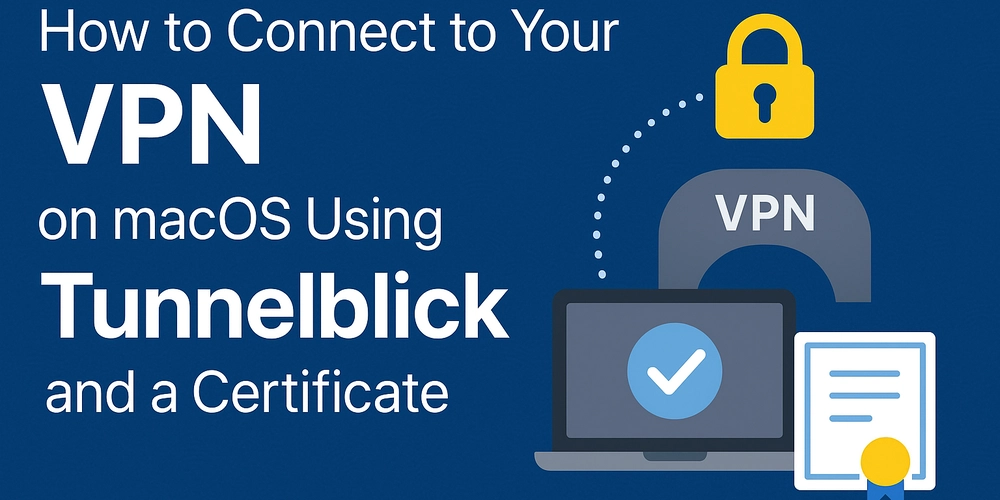Using a VPN on macOS can be straightforward when you have the right configuration files and certificates (and of course, the right guide 😉. This article walks you through the setup process step by step. By following this guide, you can securely connect to your VPN using Tunnelblick and a .p12 or .ovpn file.
Step 1: Install Tunnelblick
Tunnelblick is a free, open-source OpenVPN client for macOS.
1. Download the latest, most stable version from Tunnelblick’s website
2. Open the .dmg file and drag the Tunnelblick icon to your Applications folder.
3. Launch Tunnelblick and allow it to make changes if prompted.
Tunnelblick manages OpenVPN connections and simplifies certificate handling, making it ideal for Mac users.
Step 2: Gather Your Configuration Files
You will need:
Place both files in a folder on your Mac that is easy to locate, for example:
~/Desktop/VPNConfig/
Step 3: Add or Prepare Your Certificate for Tunnelblick
Your VPN may provide a .p12 (PKCS#12) certificate, which contains both your client certificate and private key. Tunnelblick can sometimes read the .p12 directly, but in some cases, you need to separate it into .pem files. Luckily, this guide covers both scenarios 😁
Option 1: Directly Import the .p12 File
1. Double-click the .p12 certificate.
2. macOS will prompt you to choose where to store it: Login, System, or iCloud. Choose Login.
3. Enter the password provided by your VPN provider.
4. Tunnelblick may now recognize the .p12 file. When adding the VPN configuration, you can select this certificate directly.
This works if Tunnelblick accepts the certificate without errors like “unable to load Private Key.”
Option 2: Extract .pem Files (If Direct Import Fails)
If Tunnelblick cannot read the .p12, you need to extract the private key and client certificate into separate .pem files.
1. Open Terminal and navigate to your folder containing the .p12:
cd ~/Desktop/VPNConfig/
2. Extract the private key:
openssl pkcs12 -in [your-certificate].p12 -nocerts -out [your-private-key].pem
- Enter the
.p12password when prompted. - You may be asked to create a new passphrase for the private key; you can choose to do so or skip it.
3. Extract the client certificate:
openssl pkcs12 -in [your-certificate].p12 -clcerts -nokeys -out [your-client-cert].pem
4. Extract the CA certificate (if your .p12 includes it):
openssl pkcs12 -in [your-certificate].p12 -cacerts -nokeys -out [your-ca-cert].pem
Remember to replace the placeholders [your-certificate], [your-private-key], [your-ca-cert], and [your-client-cert] with your actual file names.
5. Ensure all .pem files are in the same folder as your .ovpn configuration file.
Using separate
.pemfiles guarantees Tunnelblick can read the certificate and private key properly, avoiding passphrase and key errors.
Step 4: Configure Your .ovpn File
Open the .ovpn file in a text editor. Ensure the following lines reference your certificate and private key:
ca [your-ca-cert].pem
cert [your-client-cert].pem
key [your-private-key].pem
Step 5: Fix Cipher Compatibility
Newer OpenVPN versions require specifying data-ciphers, so add the following to your .ovpn file:
cipher AES-256-CBC
data-ciphers AES-256-CBC:AES-256-GCM:AES-128-GCM:CHACHA20-POLY1305
data-ciphers-fallback AES-256-CBC
This ensures your client negotiates correctly with the server, especially when using older or specific cipher configurations.
Step 6: Add Your Configuration to Tunnelblick
1. Open Tunnelblick and select I have configuration files.
2. Drag your .ovpn file into the Tunnelblick window (or just double click on the file).
3. When prompted, Tunnelblick may ask for your macOS password to authorize storing the configuration.
4. Choose whether to make the VPN available to all users or only your account; for most personal setups, selecting only me is safer.
5. Enter the passphrase for your certificate if required.
Tunnelblick will then store this configuration and display it in the list of available VPN connections, ready to connect.
Step 7: Connect to the VPN
- Click the Tunnelblick icon in the macOS menu bar.
- Select the configuration you added and click Connect.
- Monitor the status in the Tunnelblick window.
Common messages include “Authorizing” followed by “Connected.” If the connection loops, verify your cipher settings and certificate passphrase.
Step 9: Troubleshoot Common Issues
| Issue | Solution |
|---|---|
| Passphrase not accepted | Ensure you are using the same passphrase used during .p12 extraction |
| Certificate errors | Check that the certificate is correctly added to the Login Keychain |
| Cipher negotiation failed | Ensure data-ciphers includes AES-256-CBC and set data-ciphers-fallback AES-256-CBC
|
| Looping between Authorizing and Reconnecting | Confirm your certificate, key, and .ovpn paths are correct |
This guide provides a detailed, beginner-friendly approach to connecting to a VPN on macOS using Tunnelblick. Following it ensures your certificate and configuration are correctly set up, minimizing common errors that cause connection failures.



